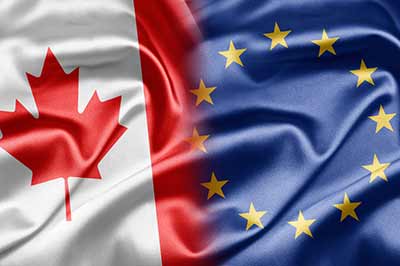The Euro (EUR) was hovering close to a 10-month low against the Canadian Dollar (CAD) and was holding at a 14-month low against the US Dollar (USD) on Monday as the single currency remained under heavy pressure from last week’s surprise interest rate cut by the European Central Bank.
Stronger than forecast building permits data out of Canada sent the ‘Loonie’ higher against the weakened Euro. According to Statistics Canada, the number of building permits issued in the North American nation surged strongly in July suggesting that Canada’s building sector is strengthening.
The number of permits issued rose to a record high as demand for apartments and condominiums soared in Vancouver, Ontario and Toronto. According to the data the value of permits for multi-unit housing leapt by 43.4% to C$2.54 billion.
The number of building permits issued meanwhile climbed by 11.8%, far higher than the 4.2% drop forecast by economists.
June’s figure was revised to a gain of 16.4% from a previously reported increase of 13.5%.
‘Low interest rates and an improving economic outlook are seemingly encouraging builders to apply. It’s unclear, however , if all those permits will translate into actual construction in the multi category whether there is reported excess supply in some cities,’ said a senior economist from National Bank Financial.
Against the Pound (GBP), the Canadian Dollar was stronger as fears over Scottish Independence weighed heavily upon the UK currency. Against the US Dollar, the Canadian Dollar remained weaker as last week’s disappointing jobs data weighed.
Also putting pressure on the Canadian currency was news that the value of Crude Oil, Canada’s biggest export declined below the $100 per barrel level for the first time since June 2013.
The US Dollar was holding at a 14-month high against the Euro as economists continue to speculate that the US economy is strengthening and as last week’s actions by the ECB continued to weigh heavily on the single currency.
Demand for the US Dollar was underpinned by the diverging monetary policy stance between the Federal Reserve and the ECB. The Federal Reserve is expected to wind up its asset purchase program in October and to start raising interest rates sometime in mid-2015.
The Euro was also weakened on Monday by the release of a report, which showed that sentiment in the 18-member Eurozone fell for a second consecutive month and its lowest level in more than a year this month.
The sentiment index compiled by research group Sentix showed that morale amongst investors in the Eurozone fell to -9.8 this month, the weakest reading recorded since July 2013. A figure above 0 indicates optimism a number below indicated pessimism.
Tuesday is devoid of market moving Eurozone data so we can forecast that the currency is likely to remain weaker against the majority of its peers save the Pound.
Euro Exchange Rates:
[table width=”100%” colwidth=”50|50|50|50|50″ colalign=”left|left|left|left|left”]
Currency, ,Currency,Rate ,
Euro, ,US Dollar,1.2946 ,
,US Dollar,1.2946 ,
Euro, ,British Pound,0.8001 ,
,British Pound,0.8001 ,
Euro, ,Canadian Dollar,1.4140 ,
,Canadian Dollar,1.4140 ,
Euro, ,Australian Dollar,1.39022 ,
,Australian Dollar,1.39022 ,
[/table]



